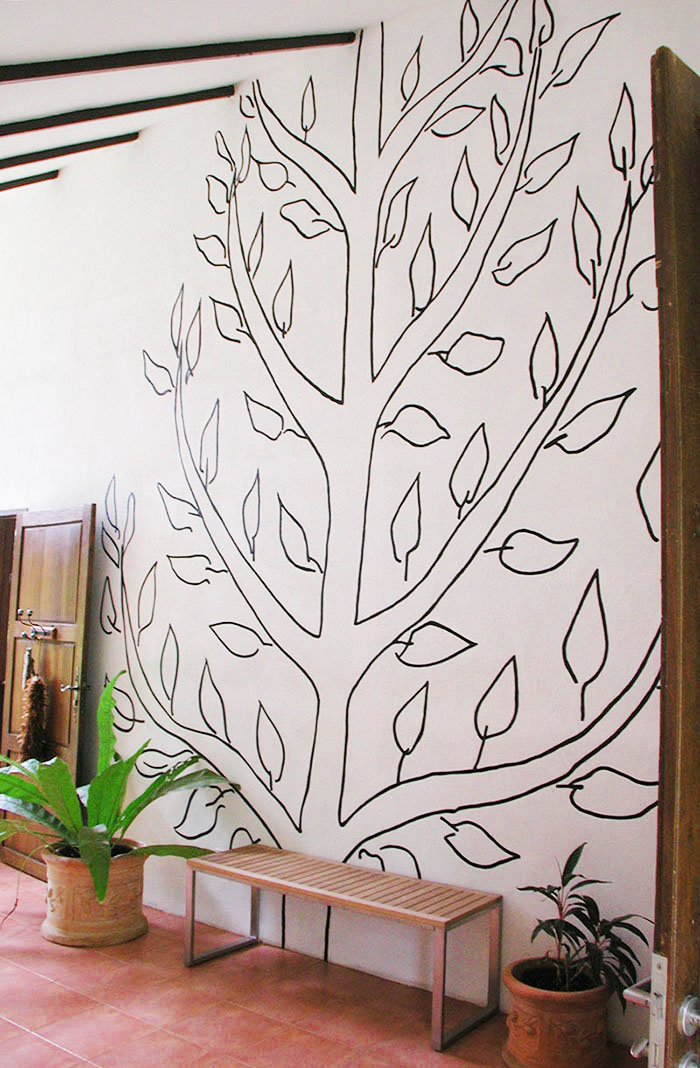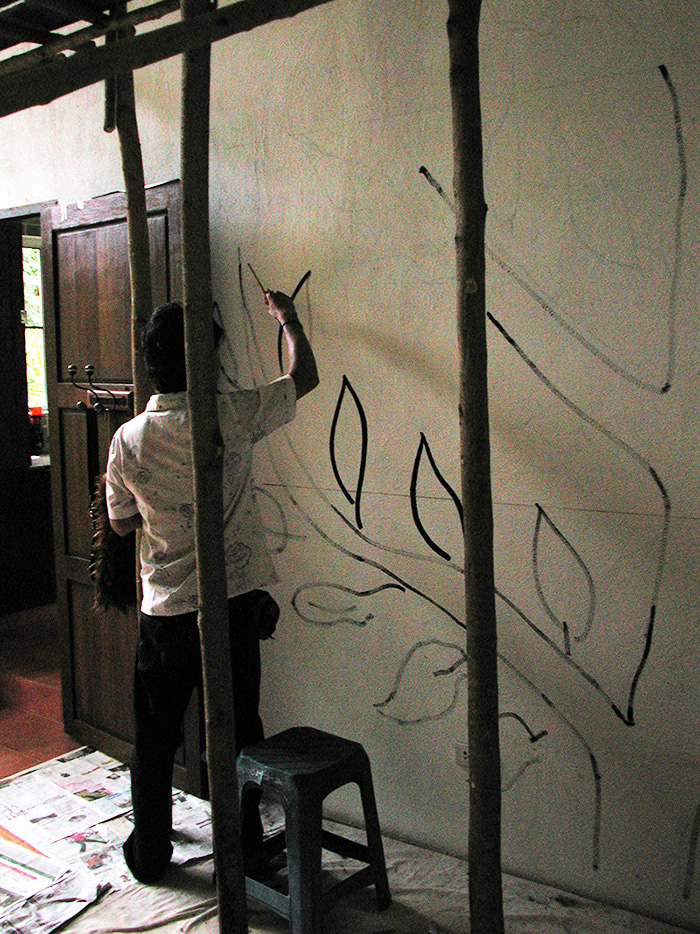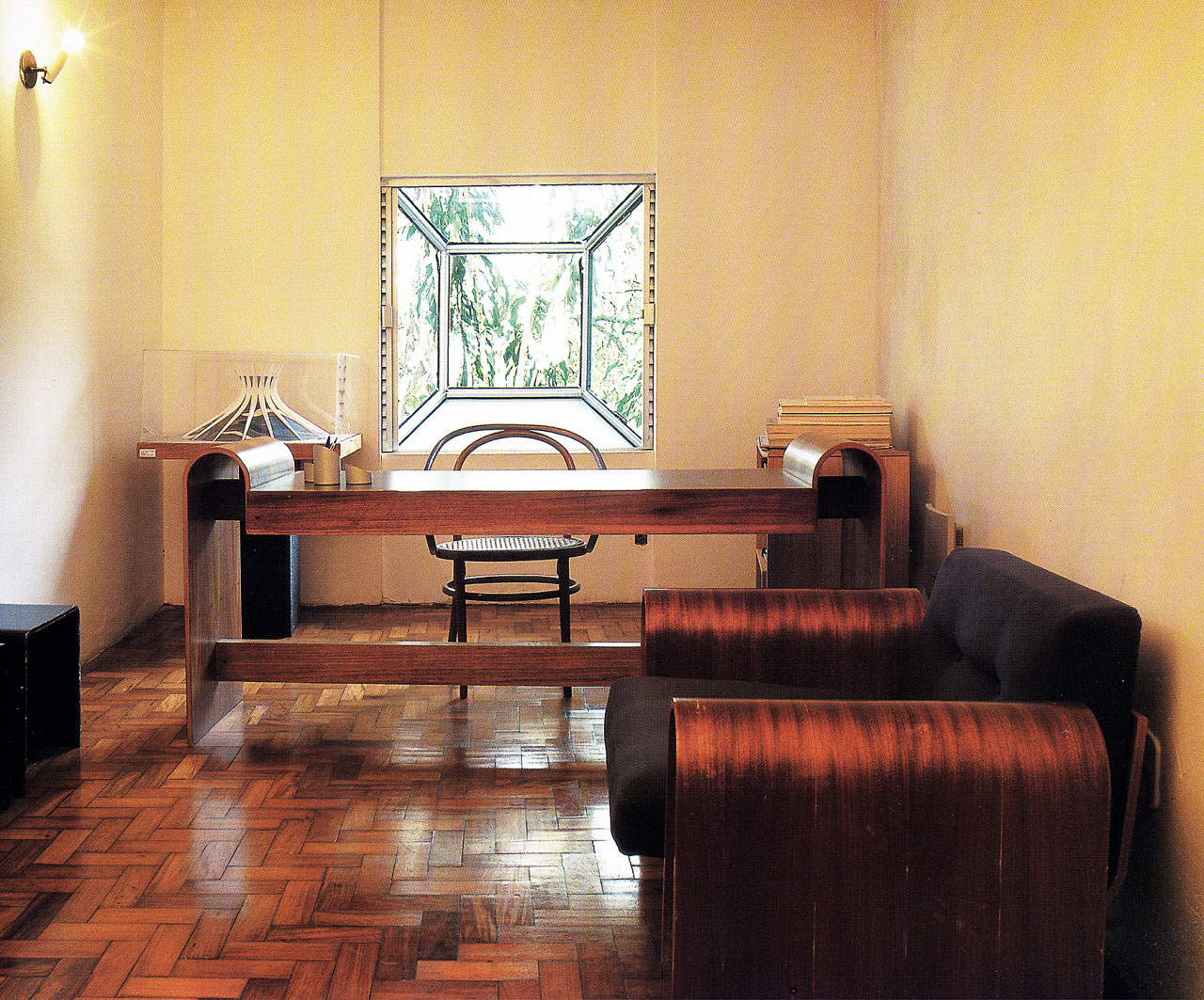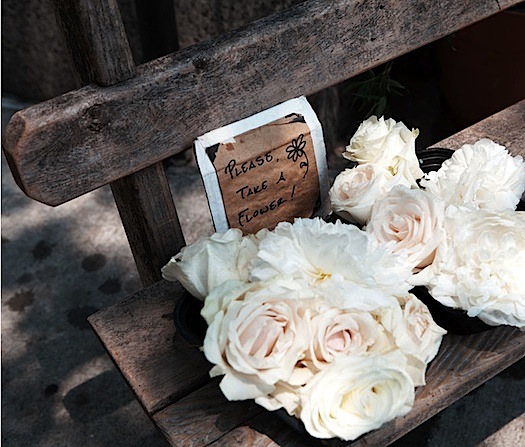A friend living in Thailand is an avid admirer of Henri Matisse, particularly his wall-size drawings. He was unhappy with the large, barren entry wall in his house in the jungle of Kanchanaburi, north of Bangkok near the Myanmar border. He dreamed of a of wall mural to enliven the long corridor to surprise his wife returning soon from an extended Stateside visit. While reading Hilary Spurling’s biography, Matisse the Master, he recalled an ink drawing of a tree he’d seen in the Matisse Museum in Nice, and later again reproduced, much enlarged, on the wall of Matisse’s masterpiece, the Chapel in Vence, below. Why not do the same in Kanchanaburi?
Thai artisans are extremely skilled in recreating artworks in scrupulous detail, and after photographing the image from a book, he hired two talented artists to reproduce the ink drawing large enough to fill the entry wall. Scaffolding was cut from trees in the garden just outside the front door…
…Working from a photograph and a simple grid made of red string…
…the artists began painting freehand…
The team two completed the work in less than half a day. A Matisse-inspired tree sprouts in a Thai jungle! Total cost about $200.
When bare walls cry out for art, why buy it and hang it? Consider painting directly on the wall. Murals have been a staple wall treatment since antiquity, beginning with the bison herds in the caves at Lasceaux, barebreasted bull riders on white plaster in Knossos, colorful Egyptian temple friezes, and Pompeiian pleasure palace frescoes. Enlarging your favorite image isn’t nearly as complicated as you might think if you use the grid method used by ancient and modern day muralists.(Check out How to Grid from About’s Drawing Guide and The Grid Method by muralist Doug Myerscough.)
Related posts: walls for painting, climbing, decorating, writing poetry
the charm of freestyle painted walls
cool designs to paint on buildings, walls, more
hubert le gall house tour: dig the fireplace!
ernst caramelle’s fab painted walls
If you’ve found illumination, joy, or inspiration in this post, please consider supporting Improvised Life. It only takes a minute to make a secure donation that helps pay our many costs. A little goes a long way towards helping Improvised Life continue to live ad-free in the world.
Support Improvised Life ♥








Why buy it? Really? I’ve loved this blog for a while but recreating someone’s creative work is not repurposing or recycling, it’s theft.
I respect Julia’s personal point of view. But as for ‘theft’, I beg to disagree.
It’s important to understand the actual legal considerations here, i.e. 1. if there was any infringement it was of the photo used as the basis of the painting, since the drawing itself was not copied, 2. Most all Matisse’s works are in the pubic domain, and 3. returning to the first point, one can copy pages from books for personal use without violating the author’s copyright.
I view the Matisse wall as an act of homage, not theft. A freehand recreation of a sketch by a much-admired, beloved artist from a photo in a book, meant to be enjoyed in the privacy of one’s home, is hardly a crime.
I recall a quote from Mark Malazarte (not Jim Jarmusch) that appeared in an improvisedlife post a couple of years ago that elaborates on this subject:
https://improvisedlife.com/wp-content/uploads/2011/04/14/jim-jarmusch-steal-from-everywhere/
“Nothing is original. Steal from anywhere that
resonates with inspiration or fuels your imagination.
Devour old films, new films, music, books, paintings,
photographs, poems, dreams, random conversations
architecture, bridges, street signs, trees, clouds,
bodies of water, light and shadows. Select only things
to steal from that speak directly to your soul. If you do
this, your work (and theft) will be authentic.
Authenticity is invaluable; originality is non-existent.
And don’t bother concealing your thievery––celebrate
it if you feel like it. In any case, always remember
what Jean Luc-Godard said: “It’s not where you take
things from––it’s where you take them to.”
I lament that copying masterworks is widely suspect in our culture, as if copying were synonymous with forgery. Copying is not trying to pass something off as the original; it’s tuning into a source of inspiration and enjoyment; it’s learning from someone else. I copy something in my sketchbook and discover, wow, that’s how s/he did that! I’m grateful to the world’s artists for being great and available teachers.